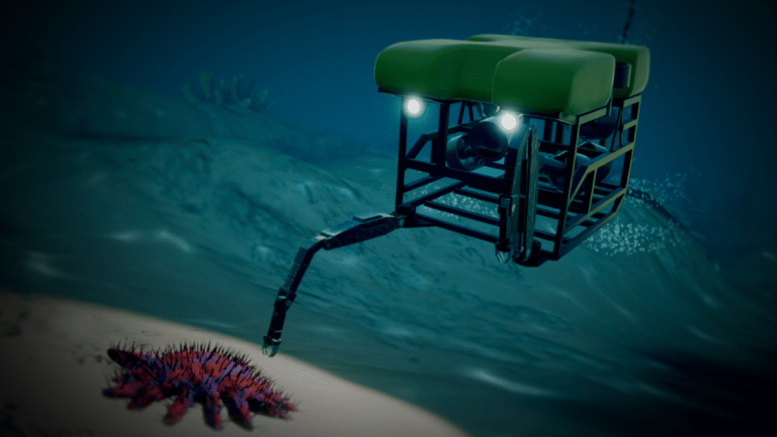Two centers and a nonprofit that are part of the National Science Foundation’s Advanced Technological Education community have created a virtual-reality simulation of an underwater remotely operated vehicle that will make its debut this summer in a global competition.
The centers are the Clemson University Center for Workforce Development and the National Center for Autonomous Technologies. The nonprofit is MATE Inspiration for Innovation.
Advanced Technological Education, or ATE for short, is a program funded by the National Science Foundation that focuses on the education of technicians for high-technology fields that drive the nation’s economy.
In the simulation, a remotely operated vehicle maneuvers through a South Pacific coral reef, hunting for the crown-of-thorns sea stars, a marine invertebrate covered with long, poisonous spikes. When the pilot finds a sea star, an injector extends from the vehicle’s arm and zaps the creature. Download the simulator here.
Players target the crown-of-thorn starfish in the simulation because it is a real-world need. The predatory sea creatures have become overpopulated and are turning colorful reefs into bleached-out wastelands. In the real world, the sea stars are injected with vinegar to control the population.
The simulation, called M8-R Sim, will make its debut in the MATE ROV Competition, an underwater robotics challenge that draws participants from around the globe.
The simulation will give pilots a chance to practice their skills.
The competition consists of 42 regional events that feed into a world championship. The 2021 world championship is set for Aug. 5-7 at East Tennessee State University. Students from middle school, high school, community and technical college, and four-year universities are eligible.
M8-R Sim is the latest example of how the Clemson University Center for Workforce Development works with partners in industry and academia to create virtual reality simulations. The center has developed more than 140 simulations, including modules that help students learn aviation maintenance, manufacturing safety and electric vehicle safety.
Kapil Chalil Madathil, the director of technology for the center, said virtual reality has successfully been used to simulate many real-world settings, helping prepare students and working adults for high-technology careers.
“Our latest virtual reality simulation was designed to support the MATE ROV Competition and to help educate students on how to operate a remotely operated underwater vehicle,” said Chalil Madathil, who is also the Wilfred P. and Helen S. Tiencken Endowed Assistant Professor of Civil and Industrial Engineering.
“Our partners with the National Center for Autonomous Technologies and MATE Inspiration for Innovation are providing invaluable support for this successful project.”
While M8-R Sim was developed for the competition, the simulation’s creators expect it will be used more widely. M8-R Sim gives students a chance to get a feel for operating autonomous technology, while raising awareness about careers in STEM, the marine industry in general and climate change’s effects on coral reefs.
Jonathan Beck, the director and principal investigator for the National Center for Autonomous Technologies, said partnerships are required to create resources such as the simulation.
“There’s no one organization that has all the expertise,” he said. “It is a constant stretch of networking and bringing together the organizations and identifying their strengths and how they can come together. We’ve got an amazing relationship with the team at Clemson University, as well as the MATE network. They are instrumental in carrying out this type of project.”
Jill Zande, the president and executive director of MATE Inspiration for Innovation, said the simulation project underscores that “the whole is greater than the sum of the parts.”
“To bring everyone together for a common mission– all this expertise– it’s huge,” said Zande, who is also founder of the competition. “We would not have been able to accomplish this without Kapil and the Clemson team or without Jon recognizing the opportunity and bringing everybody together. I think these partnerships speak to the collaboration in the NSF ATE community as a whole being a very collaborative group.”
MATE Inspiration for Innovation, also called MATE II, is a 501(c)3 non-profit corporation inspired and created by the Marine Advanced Technology Education (MATE) Center at Monterey Peninsula College. MATE II was founded to support and sustain ongoing education activities and programs initiated at the MATE Center, including the MATE ROV Competition. The MATE Center is funded by the Advanced Technological Education program.
Rebecca Short, the director of operations for the Clemson University Center for Workforce Development, said that partnerships with academic and industry partners are critical.
“We’ve always worked with two-year colleges to vet and pilot our material,” she said. “But now because the number of people working and learning from home has increased during the pandemic, the demand has greatly increased. The rising demand has made virtual reality simulations– and the partnerships to create them– more important than ever.”
Jeff Bertrand, the director of visualization for the Clemson University Center for Workforce Development, added: “It is exciting to be involved in this dynamic collaboration with the National Center for Autonomous Technologies and the MATE Inspiration for Innovation. Together we are creating innovative virtual reality simulations that are shaping the workforce of the future.”
Daniel L. Noneaker, associate dean for research in Clemson’s College of Engineering, Computing and Applied Sciences, said collaborations are key in preparing future generations of technological talent.
“Working with academia and industry, the Clemson University Center for Workforce Development is developing high-impact e-learning materials that help create a diverse, well-prepared pipeline,” he said. “The ROV simulation is the latest example of their transformative work. I congratulate all involved with completing this successful project.”


Be the first to comment on "Clemson Partners On Underwater Robotics Challenge"